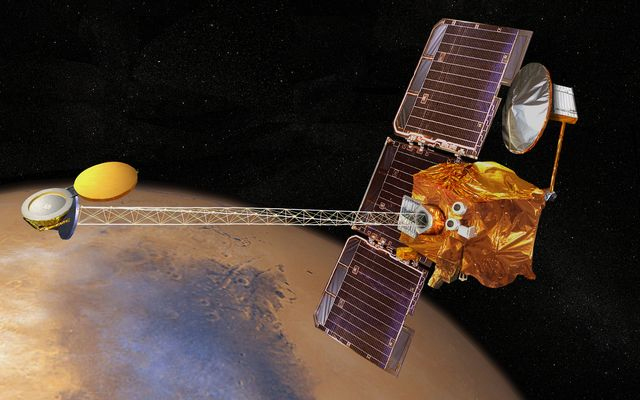Mars Odyssey Spacecraft Bounces Back from Glitch at Red Planet

NASA's veteran Mars Odyssey spacecraft orbiting the Red Planet is out of the woods after a glitch stalled the probe's science operations earlier this month.
The 11 year-old orbiter went into protective safe mode on June 8 after its onboard computer detected a problem with one of the three reaction wheels that control its orientation. One of these wheels jammed temporarily, so mission controllers instructed Mars Odyssey to use a spare it had onboard.
Mars Odyssey uses a trio of spinning reaction wheels to maintain its orientation in space without the use of thrusters, which consume precious thruster fuel. Until recent tests this week, the spare wheel on Mars Odyssey had not turned since before the spacecraft launched toward the Red Planet in 2001. A shakeout of the wheel spun it up to 5,000 rotations per minute, mission managers said.
With the spare wheel up and running, Mars Odyssey has succesfully shifted out of safe mode (which pointed the spacecraft at Earth for better communications) to its normal downward direction facing Mars, called nadir.
"Attitude control in nadir pointing is being maintained with the use of the replacement wheel, and the suspect wheel has been taken out of use," Odyssey project manager Gaylon McSmith of NASA's Jet Propulsion Laboratory in Pasadena, Calif., said in a statement.

"Remaining steps toward resuming all normal spacecraft activities will probably be completed by next week," officials said in the statement.
Mars Odyssey launched in April 2001 and has been orbiting the planet for more than a decade, longer than any other Mars mission in history.
Get the Space.com Newsletter
Breaking space news, the latest updates on rocket launches, skywatching events and more!
The orbiter has been mapping the surface of Mars to study its chemical and mineral distribution, and it also serves as a relay station to pass on data collected by landers on the planet back to Earth. Mars Odyssey is a primary relay station for NASA's Mars Exploration Rover Opportunity, and will also serve the Mars Science Lab rover Curiosity after it lands on the Red Planet in August.
Follow SPACE.com on Twitter @Spacedotcom. We're also on Facebook & Google+.
Join our Space Forums to keep talking space on the latest missions, night sky and more! And if you have a news tip, correction or comment, let us know at: community@space.com.

Clara Moskowitz is a science and space writer who joined the Space.com team in 2008 and served as Assistant Managing Editor from 2011 to 2013. Clara has a bachelor's degree in astronomy and physics from Wesleyan University, and a graduate certificate in science writing from the University of California, Santa Cruz. She covers everything from astronomy to human spaceflight and once aced a NASTAR suborbital spaceflight training program for space missions. Clara is currently Associate Editor of Scientific American. To see her latest project is, follow Clara on Twitter.









